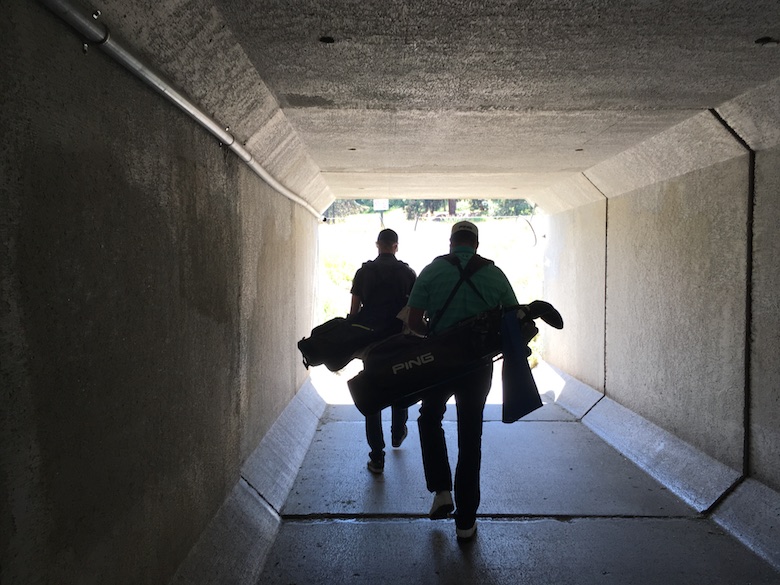Bakker Crossing Charity Pro-Am
Bakker Crossing Golf Course, Sioux Falls, South Dakota
Final Round: July 10, 2017
I played the Bakker Crossing Charity Pro-Am this past weekend and played well, just not well enough. I shot -2 over the two days. The cut was -5.
My good friend Ryan made the cut and asked if I wanted to caddy. With the day off, I certainly wanted to help my buddy out and was excited to do it. And as it turns out, the experience was helpful for my own mental golf game, as well.
Caddy Talk
It was different hitting the course today – not as a player, but as a caddy. It takes a different mindset. One that could very well be helpful when you do hit the course as a player. Starting things off, it was important to support my friend in a way that works best for him. We agreed early on that he wants me to say whatever I am feeling, and he trusts my judgement.
So, I was able to say what’s usually internal dialogue out loud, which is a really great exercise for any professional golfer on the tournament track.
Overcoming Tournament Challenges
Every professional tournament has its challenges. One of the challenges that we encountered right away: being put on the clock. We were the second group out in the morning, but we had a player in our group playing slowly. The rules official told us on hole 5 that we had to speed up the pace and if we did not catch up by hole 8, we would be penalized. This definitely added another layer to an already-challenging final round.
Establishing Golf Strategy
So for the next four holes, we were playing ready-golf and fast. To put this in perspective: Groups are usually allotted 15 minutes per hole. We had 40 minutes total to play four holes – 10 minutes per hole. I dialed in on helping Ryan – and the group – keep up the pace, so he could remain focused on his shot. I was running ahead after he hit his tee shot to get the distance, so when he got there we would grab a club and hit it. It was a difficult few holes, but once we got to the back nine, we were even par.
At this point, it was time to discuss strategy again. What will it take to win this tournament today? Land on the money list?
I told him: “Let’s get one birdie every three holes.” And that’s what we did. But better.
On 10, we made a bad swing from the fairway and missed short right of the green. Ryan hit a great chip and saved par. It was the kind of par save that really helped our momentum. We pared 11. Birdied 12. Perfect. The strategy is working: -1 through 3 holes.
Instilling Confidence
On 13, we hit a good shot, but just missed the putt. The 14th hole was a par 4 at 460 yards. We hit one pin-high. We had a 25-foot putt ahead of us. There was discussion on whether it moved left at the end. I was not convinced. Working as the caddy, it was my job to not only read the greens, but instill confidence in my player. So I told him to just trust the line and it would straighten out at the end, he agreed and struck the putt. The putt rolled perfectly end over end… into the back of the hole for a birdie.
Next hole, we missed birdie. Eagled number 16 with a perfect drive, perfect second shot, and a great putt from 8 feet.
Reviewing Club Selection
One of the things that creeps into any player’s mind while in a professional tournament: Am I choosing the right club?
On hole 18, they moved the tee box up 30 yards shorter from the previous two days. The goal was to get in the fairway and give us a chance for another birdie. It was only 180 yards to reach the water on the right, and we decided that the 8 iron would not get us there even if we did hit it at the water. He hit it perfect in the left fairway, and we proceeded to hit the green and leave a 15 footer that we just missed.
Final score: Ryan finished the day -4 under par 67. He placed T11. Overall, he had a really impressive round – especially with the day’s unique challenges – and I was honored to be a part of it.
Mental Golf Game Takeaways
So how did caddying for a friend end up helping my own game?
- Saying Strategy Out Loud: I always talk to myself during the round, but never actually say it out loud. It made a difference to hear it. It reinforced my initial convictions and confidence on the slope of the green, wind direction or club selection.
- Step Outside Yourself & Relax: There were times when I could feel the nerves going. But I had to be there as a support to my player, stay in the moment and not second-guess my gut feelings. For instance, it was a one-club wind all day. There were a few times early-on that we thought it might be two clubs, but our initial read was ultimately correct. This might be a good mental exercise during a professional tournament: to think like a caddy and not the player.
- Play to Your Strengths: Recognizing that if you feel amped up and the adrenaline is flowing, be sure to club down.
So, if you ever have time while grinding on the tournament track, consider taking part of a professional tournament as a caddy or spectator for a day. It can be an extremely helpful exercise. An opportunity to see the game from another perspective and work out those mental muscles.




